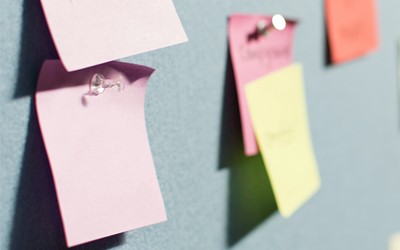Home / Thinking Zone / Does Art Have to be Beautiful?
Does Art Have to be Beautiful?
Over the summer I visited two completely different art exhibitions - Women in Revolt! Art and Activism in the UK 1970-1990 and Beyond Van Gogh, the Immersive Experience.
Both were engaging in very different ways, and whilst one was a far ‘easier’ and a more conventionally beautiful experience, both exhibitions left me with many questions – in particular whether aesthetic beauty within art is inherently necessary – or whether curiosity and stimulation is better?
Posted 24 September 2024
The philosophical connection between beauty and truth
The connection between beauty and truth was explored by Greek philosophy long before Keats famously wrote that "Beauty is truth, truth beauty," – and historically, the belief that art should express these linked qualities seems to have persisted. Plato believed that beauty was a manifestation of a higher, eternal truth, arguing in The Symposium that the appreciation of physical beauty can lead one to the contemplation of the ultimate, unchanging truths, known as the Forms - and subsequent philosophy and art criticism is peppered with arguments both for and against these seemingly interchangeable concepts. One prominent figure who adhered to the ‘beauty and truth’ argument was the 19th-century art critic and historian John Ruskin who believed that art should express both beauty and truth, emphasizing that truthful representation of nature and the human experience was central to the value of art.
The modern shift: art beyond beauty
In our visually saturated modern world, does the unspoken rule of art still whisper to us that art must be beautiful in order to be true? Perhaps. But the requirement of art to be beautiful as one of its central tenets has actually been waning for a very long time and it is now widely acknowledged that art has many other important functions – communication, commentary, interpretation to name but a few. However, how much does the concept of a ‘beautiful artwork’ still have resonance for the creator and/or the viewer in 2024? You might not even realise how much chasing ‘beauty’ is imbued into what we take in visually, and ultimately, what we buy into. The age-old saying goes that beauty is in the eye of the beholder but it sometimes doesn’t feel that way.
Impressionism and the break from traditional beauty
Exactly when attitudes began to change regarding this connection between beauty/truth and art is debatable, but many art historians would cite Impressionism as the beginning of artists breaking away from traditional academic standards of beauty – focussing instead on brush technique and capturing the fleeting essence of light as a subject. It is ironic that now, Impressionist (style) painting is often seen as traditionally ‘beautiful’ art– particularly for domestic collectors - because at the time it was heavily criticised for looking ‘incomplete’ and ‘undignified’. Expressionism, Dadaism, Cubism and Surrealism all followed on from Impressionism in their own distinct ways, each playing with traditional notions of beauty, often by deconstructing objects and/or the human form into abstracted shapes and drawing parallels with traditionally ‘ugly’ concepts (a prime example being Duchamp’s urinal, Fountain of 1917.) And whilst much of this was due to changing societal values, industrialisation and war – the notion of art not having to be beautiful was certainly in the mix.


Images: Marcel Duchamp, ‘Fountain’ 1917 & Claude Monet, ‘Impression Sunrise’, 1872. Both were considered to be ‘unattractive’ in their day.
Feminist art: challenging beauty and representation
Formerly at the Tate in London and currently on show at the National Galleries of Scotland (Modern 2), Women in Revolt! curated by Lynsey Young, is a major survey of feminist art, celebrating the women whose radical ideas and rebellious methods changed the face of British culture. It is deeply engaging and touches on so many important issues such as motherhood and domesticity; the Women’s Liberation Movement; gender (in)equality; the influence of Punk; political issues such as anti-nuclear protests (Greenham Common) and the AIDS epidemic. It also highlights how women used art as a method for highlighting concerns in all areas, as well as reflecting on the intersection of race and gender within feminist discourse. The role of women as beautiful objects was also challenged throughout – indeed, the main publicity image for the exhibition is a still from Gina Birch’s ‘3 Minute Scream’ video, a piece specifically intended to be an unfiltered depiction of ‘unattractive’ female rage.

Image: Gina Birch, 3 Minute Scream (video), 1977, courtesy of the artist.
Women in Revolt! Art as activism and feminist history
As a practicing artist myself and having lived through many of the political events and societal changes which were referenced in Women in Revolt! - as well as experiencing the challenges of making art as a woman - it was incredibly interesting and thought-provoking to spend time at the exhibition. It made me wonder (anew) about what art is… is it something which should provoke and inspire regardless of how beautiful (or not) the output is? And is a gallery setting the right one for this kind of exhibition – one which has been questioned for being more of a display of art activism and a social history of feminism between 1970-1990? Interestingly, many of the works on display in the exhibition were sourced directly from the artists and not from the Tate’s collection – something which curator Lynsey Young was proud of: These women have been recognised for a long time within their own communities, all that’s happening here is that we’re widening access to their work. It is incredibly important to me that this happens and that we continue to agitate the institutional ‘rules’. Do you have to have gone to art school, had a million exhibitions, be rich and famous to show in the Tate?
Defining art: does it matter what we call it?
Whilst Women in Revolt! was certainly covering a huge range of complex issues, challenging to absorb in only one visit, the pieces I found particularly fascinating were the ones which explored traditional depictions of women within society. Superficially, attitudes have changed a lot – for example, you would not see a car advert such as this one in 2024:

Image: Jill Posener, Fiat Ad, London 1979, reprinted 2023. Courtesy of the Artist.
The influence of popular culture on beauty ideals
However, when asked in an interview with Artists Responding To, which of the issues were still problematic for women today, Lynsey Young said this:
So many. Safe childbirth, equal pay, childcare, inequality in healthcare, police brutality, austerity, racism. It would be quicker to list the things that have changed!

Image: Penny Slinger, Bride and Groom, 1973
Trying to define whether Women in Revolt! is an art-activism archive (or not) is an interesting topic, but I wonder if it really matters? Surely to put any constraints on defining what is art is or where it should be is fundamentally stifling? Art, by definition, cannot be constrained by rules on what it is or is not.
As an aside, idealised portraits of women which were such a feature of art history, and went hand in hand with attitudes towards women as objects, has perhaps now been taken up by popular culture and advertising. Chasing the notion of a ‘perfect’ face and body still seems to exist (despite many attempts to quell it), and social media is littered with unattainable depictions of beauty with society and the media still subliminally telling us there is a (judgemental) ‘value’ around the appearance of women.
The Van Gogh immersive experience: art or spectacle?
Whilst a completely different content and format to the gallery housed Women in Revolt! exhibition, the Van Gogh experience has raised similar questions amongst art critics around the definition of what ‘real’ art is. The digital, animated reproduction of paintings – named by some, as a glorified ‘slideshow’ has received its fair share of criticism, and since its inception a few years ago. There has been a lot of what might be termed ‘art snobbery’ around the immersive experience format in general - which has seen a huge rise in popularity and spawned a host of other interactive experiences from artists of similar ‘blockbuster’ status.
Accessibility vs. authenticity: the role of digital art
The Van Gogh Immersive experience is a multi-sensory exhibition created by the Belgian company Exhibitions Hub in collaboration with Fever, and digital film maker and artist Massimiliano Siccardi. Currently travelling across more than 40 countries worldwide and using cutting-edge projection mapping and virtual reality to immerse visitors in Van Gogh’s iconic works, it claims to offer a 360-degree digital experience for people of all ages. The exhibition allows viewers to interact with animated, large-scale versions of Van Gogh’s paintings, creating an engaging fusion of art and technology and it is certainly on an impressive scale.

Emotional engagement: the power of art in all its forms
But is bigger necessarily better? Van Gogh’s paintings were never intended to be seen so large and I did feel that some of the incredible brushwork in the originals was hastily mimicked and somewhat lost by the fuzzier, digital reproduction. How much was the exhibition trading on the emotional story of Vincent as the tragic artist, his life of hardship and his compulsion to create his work? The immersive experience has been described as ‘more Instagram than art museum’ (Review of the Original Immersive Van Gogh Exhibit - The Geographical Cure) – and whilst this is perhaps harsh – there is something of that within the experience.
However, a common maxim, which I wholeheartedly agree with, is that art is for everyone, so I loved the accessibility of the digital format and the way it seemed to reach people emotionally -just as much as physical art can do. Like many, I have been lucky enough to see a lot of Van Gogh’s works in the flesh over many years - and they are familiar and meaningful to me because of the legacy of association within my own life. It is difficult to untangle how much of my enjoyment of the experience was because of this existing intimacy with the paintings and whether, if I hadn’t had this, my experience would have been lessened. Similarly, I loved re-reading the letters between Van Gogh and his brother Theo (which are displayed on illuminated screens at the beginning of the exhibition and also read aloud during parts of the animation), but I wonder how they would have felt having their private correspondence on show like this? Is it engaging a new tech savvy audience by bringing to life the characters of the day or is it butchering their brotherly connection and Van Gogh’s art? Where does the intention of the artist come in or would Van Gogh have been pleased with how his work is now being experienced? It’s difficult to know.
Art, beauty, and provocation
Women in Revolt! and the Van Gogh experience were engaging in very different ways and you could say that they were on opposite sides of the ‘beauty is truth’ argument. Van Gogh was like being immersed in a dream of colour and feeling which took you to another place emotionally; whereas Women in Revolt! was a stimulating, thought-provoking and often disturbing exhibition which has deep resonance and relevance for both women and men. Both exhibitions were what might be termed as mainstream, but I don’t think that should lessen or strengthen their impact; in very different ways it was clear the art was moving people, sparking their curiosity and making them feel, which for me is the true measure of art.


Images: Beyond Van Gogh, illuminated quotes & Maud Sulter, Urania from the series Zabat, 1989
And finally...
Dig a little deeper into the Van Gogh experience and think of the artist at the heart of this – he was a man who was often shunned by fellow artists, hardly sold a painting in his life and ultimately was a victim of his own mental health struggles. Similarly, many of the artists and subjects within Women in Revolt! were living through hardship, prejudice and inequality. Whether an artist has to suffer is a whole other topic, and there is so much more to say on these two very diverse exhibitions and their ramifications – but it is perhaps interesting to note how the role of technology and the concept of beauty in art can be juxtaposed and considered within the same spheres of thought.
Go and see an art exhibition the next time you have a space in your diary – you never know what it might spark!

P.S. Coming up next our Creative Thinker in Residence will be exploring how AI and art have become intertwined – watch this space!
Get in touch
At eCom we love to hear from people so if you have enjoyed this content from the Thinking Zone or would like to pose a question to our Creative Thinker in Residence then please do get in touch or follow us on LinkedIn.












